
Abnormal combustion, more commonly known as knock or detonation, has been the limiting factor in internal combustion engine
power generation since the discovery of the otto cycle itself. To tune an engine for maximum power, you need to understand this
undesirable yet ever-present problem.
Abnormal combustion manifests in many different ways. To the typical enthusiast, all abnormalities are referred to as knock or detonation. In practice, though, when the undesired flame front is initiated and how it is propagated define the cause and, in turn, the appropriate cure.
Abnormal combustion got the nickname knock from the noise that is transmitted from the colliding of the multiple flame fronts and the increased cylinder pressure that causes the piston, connecting rod and bearings to resonate. Any sort of abnormality in the combustion process has serious consequences in the power output, longevity and emissions generation of an engine.
Trying to isolate a detonation problem in a highly modified or even slightly modified engine requires you to determine if the combustion problem is being caused by a change you made to the engine, is inherent to a design flaw, or is derived from an external cause such as carbon deposits or poor fuel. Obviously the area with the largest variable is the fuel quality. Octane determines a fuel's ability to resist auto-ignition, or in lay terms, its ability to wait for a spark to initiate a flame. For our purposes we will explore knock independently of fuel octane rating.
When knock occurs, there is uncontrolled combustion with multiple flame fronts, with only one of them being initiated by the spark plug. During knock, cylinder pressures experience an extremely rapid rise and spontaneous burning and release of the end gases' energy. It is not uncommon to see a pressure rise of up to 8 bars per degree of crankshaft angle, or up to 50,000 bars per second. Anything that will either increase heat or retain heat in the combustion chamber will promote auto-ignition.
Common problem areas are sharp edges of metal either on the piston or in the combustion chamber. For instance, if the piston has a valve relief cut into it, there is usually a very defined edge that the cutting tool leaves. This sharp edge is greatly prone to super heating and will actually retain enough heat that it will start to glow. If the fuel should hit this glowing edge either prior to the lighting of the spark plug or even after ignition, it is very likely that another flame front will initiate. If this unintended ignition occurs very early in the compression stroke, then the piston will be forced up against the increased pressure of the burning gas and will result in a form of abnormal combustion referred to as preignition. When this happens, the end result, if severe enough, is that the connecting rods bend. Turbocharged engines are specifically prone this. Carbon deposits that build up in the combustion chamber or on the piston top will have the same effect, along with the decreased volume at TDC, which in turn raises the compression ratio.
As stated earlier, anything that will raise temperatures in the cylinder will help promote detonation. This rise in temperature could occur many different ways: very lean air/fuel ratios, heating of the charge air prior to entering the combustion chamber, compression of the air molecules from forced induction, or poor heat dissipation through the cooling system. Increase of cylinder pressure will also prompt detonation. Camshaft profile, compression ratio and quench area all come into play. Design criteria as to combustion chamber shape and mixture motion, spark plug location and piston design can all make an engine more or less inherently prone to abnormal combustion. Naturally, spark timing and fuel quality round off the list.

Other than running an engine without oil, there is probably nothing that you can do that is more detrimental to an engine than detonating it. In an ideal combustion cycle there is a controlled burning of the compressed fuel and air, but during detonation there is an exploding of the mixture with a instantaneous release of all its energy, regardless of where the piston is in its stroke. The timing of the auto-ignition will have a direct effect on where the damage takes place.
Detonation very early in the compression stroke is usually the silent killer that goes unheard by the driver. This form of combustion usually results in rotating assembly failure by attacking the connecting rods and bearings. Detonation that comes nearer to TDC or slightly after is usually heard as pinging and will likely result in the burning of the piston or the lifting of the ring land from the piston. The force from the colliding of the multiple flame fronts can be likened to the wake of two boats travelling in opposite directions on a lake. When the two wakes meet, they usually peak and absorb the energy of each other. The more dominant wake will still have some leftover energy and will proceed weakly in its original direction. The same holds true for colliding flame fronts in a cylinder. If you have one flame initiated at the spark plug and another started independently of the plug, usually the spark-initiated front is the dominant one. As the two flame fronts collide, the pressure in the cylinder rises from the compacting of the molecules. Historically, the normal flame front has enough energy to run over the abnormal one but uses a lot of its energy to do this. Add to this that the abnormal combustion has consumed a portion of the combustible mixture that filled the cylinder, and the least result is a loss of power, if not a damaged engine.
Figure 1 Auto ignition sites
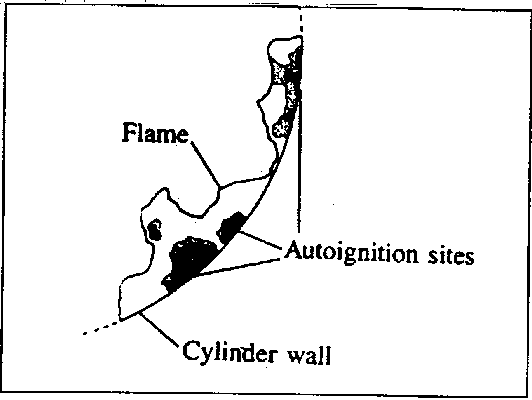
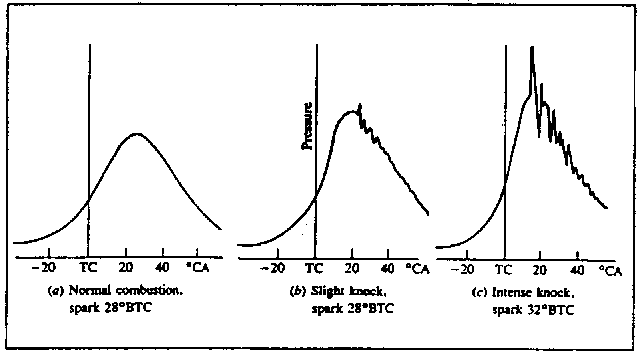

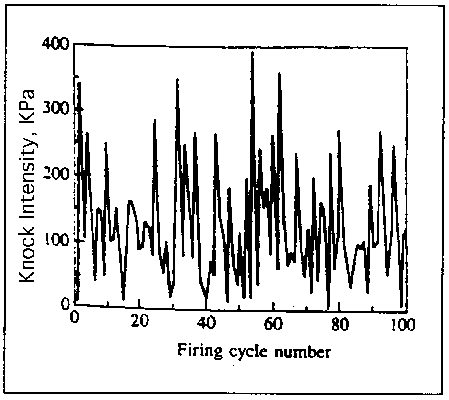
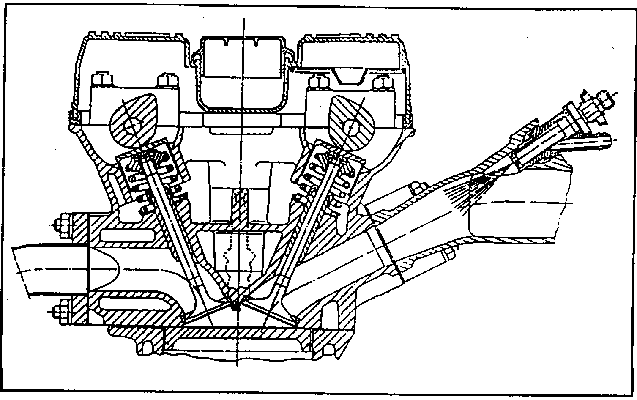
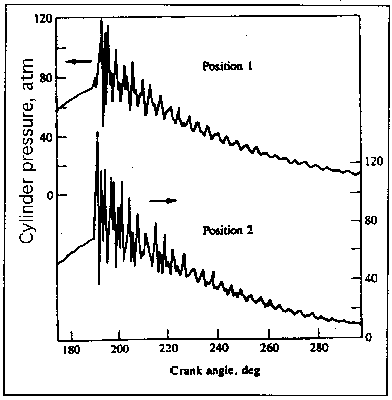
Today's performance cars have a lot of technology and designs that make detonation less likely than it was years ago. As a matter of fact, we don't think we've ever heard a new LT1 or Mustang OHC modular engine ping audibly. But the key word is "audibly." Even though you may not hear it, an engine can still be experiencing abnormal combustion.
When looking to modify a fuel injected engine, you need to take a systems approach to get the best results. For example, if a supercharger is your power adder of choice, you must first look at your base engine to see what you have. It is my opinion that if you are using a stock piston and the stock compression ratio is at 10.0:1 or better, you must add an intercooler. Cooling the charged air regardless of the compression ratio is always desirable, but with a higher compression ratio it's a must.
Inherently, small-bore engines are less prone to detonation than those with larger bores. The less distance the flame has to travel, the less likely there is for something to go wrong. By using reflective thermal barrier coatings on the top of the piston and the combustion chamber and quench area, you allow the flame to travel smoothly and keep the piston and head surface below the coating cooler. The actual temperature of the coating will be hotter but will reject that heat back into the combustion process to make power. Also, engines with coated pistons need less timing than uncoated pistons that pull heat out of the combustion process. For example, a 383 LT1 that I just built made 477 lbs-ft. of torque and 496 hp on pump gas running only 36° timing using pistons and heads that I coated. Normally, a combination like that would want nearer to 40° advance. By limiting spark advance at maximum brake torque, you are drastically reducing the chances of detonation.
Chevrolet's LT1 engine employs a method called Reverse Flow Cooling, which redirects the engine coolant into the cylinder head first, instead of its traditional entry point, the engine block. By doing this, more heat is pulled out of the combustion area, which, by itself, is a negative, but allowed for higher-than-normal compression ratios without detonation. The net result is a slight loss of thermal efficiency but a gain in power without detonation by the raised compression.
Another area that has evolved greatly in detonation suppression is the combustion chamber design. Today's small, fast-burn high mixture motion chambers combat the likelihood of detonation (see "Volumetric Efficiency,'' Nov. '96). If replacing a cylinder head with an aftermarket one, try to employ a head that mimics today's combustion chamber technology to make abnormal combustion less of a problem. Since leaner air/fuel ratios create more heat, you might want to try running a slightly richer mixture to cool off the combustion temperatures to quench detonation. The small amount of horsepower that you lose will buy a lot of longevity. This is particularly true when dealing with forced induction. A turbocharged or supercharged engine will hardly lose any power to a slightly rich air/fuel ratio, but the dividends the additional fuel will pay in cooling will be greatly appreciated by the pistons.
If detonation limits power, then spark advance, or the lack of it, limits detonation. When chasing an abnormal combustion problem, one of the first areas that you may want to turn to is the retarding of the spark. With a distributorless ignition or an LT1 with an Optispark ignition, this can only be accomplished electrically, which complicates matters. If pulling timing out of an engine doesn't suppress or eliminate knock, then most likely your problem is rooted in carbon deposits or a hot spot on the piston or combustion chamber. At that point you may want to remove the carbon chemically without dismantling the engine.
Another area that's often overlooked is detonation on one or two bores in lieu of all or most cylinders. It really takes a trained ear to determine this by the frequency of the knock and its sound. Then again, there's something particular to those bores only that is causing a problem. An often overlooked area is oil migration into the bore as a cause of detonation. If you're searching for the culprit, carefully examine the spark plugs under a magnifying glass. Oil originating at the valve guide area is a major contributor to single-cylinder detonation. Retarding of the timing may lessen this but will drastically diminish power output in all the normal combustion bores.
Today there are many different ignition safeguards that can be incorporated to lessen knock. Since they are all ignition-related, it must be understood that they can only cure abnormal combustion that responds to spark timing. If there's an above mentioned hot spot in the cylinder, ignition delay from TDC will have little or no effect. If running a forced induction system, it would be desirable to use a boost activated spark retard. The best ones allow you to adjust the amount of retard vs. the amount of boost. For example, you might need only 2° retard at 4 lbs. of boost, but by 6 lbs. you might need 5°.
What I would really like to see on the market, but no one makes to the best of my knowledge, is a retard system that incorporates a knock sensor without closed loop control. What good is being able to retard the timing if you don't know if a knock exists and at what point it ceases? There are independent stand-alone knock detection monitors, but they seem to be unfiltered and acknowledge a multitude of vibrations.
Most modern engine management systems incorporate a knock sensor or two (LTIs use one on each side of the block) for closed loop timing control. These systems only have a limited amount of control and are designed to stop detonation in the normal operating range of the engine, not to compensate for 12 lbs. of boost on a 95° day. The sensor itself is a piezo-electric accelerometer, or a sort of an electronic tuning fork. It's tuned to create an output voltage and is designed to bore and chamber geometries. When a given frequency of knock is detected, it in turn sends a signal back to the ECU identifying detonation, and the ECU retards timing
When trying to get maximum drag strip performance out of a feed-back timing control engine, you might want to disconnect the knock sensor. The sensor is designed to listen for vibration, and it does a very good job. Anything that can cause a harmonic might be picked up by the sensor and be interpreted as detonation. The major problem with that lies in what is called the hysteresis of knock. Once knock starts, you need to pull out more timing than would originally be needed for knock to ever occur. For example, if your Z28 makes maximum torque and doesn't detonate at 38° advance and you advance the timing to 39° and detonation occurs, the knock sensor may have to pull the timing out to 30° to stop the knock. There goes the timing and there goes your ET and mph. Also, at WOT the engine might knock, just for a millisecond, and bingo, there goes the timing. If you have an exhaust that shifts slightly during hard acceleration and vibrates, say goodbye to advance again.
The cure is to run good unleaded fuel; around 100 octane works best with today's performance cars. And you should also disconnect the knock sensor. It's funny how racers will spend thousands of dollars to modify their engines and be too cheap to put good fuel in when they race.
Most new GM vehicles use the knock sensor during the first few seconds of operating to test the knock control system. If it doesn't get a signal back from the sensor, it will send a knock control trouble code and illuminate the Service Engine Soon light. So if this knock sensor trick works for you, just splice a toggle switch into the knock sensor wire and open the switch before you make your run.
This trick is usually good for 0.1-0.2 seconds and 1-2 mph.
The following is a simple guide for eliminating knock.
1. Maximum compression on pump gas is around 10:1 with cast-iron heads and 11:1 with aluminium heads. With older combustion chamber designs like that of the L98, stay on the low side of 11 :1, around 10.75:1. If you want to add a supercharger or nitrous, drop the compression ratio 1 point.
2. Monitor detonation and set timing accordingly. Use a detonation monitor and do your best to decipher noise from knock
3. Remember, small changes in the advance curve at a given point pay huge dividends in knock reduction and power output.
4. If you are building an engine from scratch, choose a head with a fastburn chamber and pay special attention to sharp edges on the pistons or combustion chambers. These sharp edges must be removed.
5. Coated pistons and cylinder heads work in quenching detonation and making more power.
6. Monitor air/fuel ratio and use the cooling effect of additional fuel in your tuning.
7. Try to feed the engine as much cold air as possible. Fuel injected engines use a dry flow intake manifold that doesn't have the benefit of the vaporising fuel for cooling that a carburettor has.
8. Run the best unleaded fuel you can. If the compression ratio of the engine is up near 11.0:1, it will love 100-octane unleaded. Remember, the higher the octane, the slower the fuel burns.
9. Whenever possible, intercool a forced-induction engine.
10. Pay attention. Listening to your engine will stop you from hurting it. Your right foot is the greatest safeguard ever built.
In conclusion, abnormal combustion is a problem that has been around for a long time and is the foe of every performance enthusiast and engine design engineer around the world. But by understanding detonation's origins and what can be done to cure it, you will spend more time driving and enjoying your car, instead of replacing the pistons.